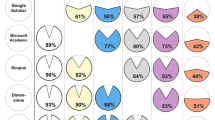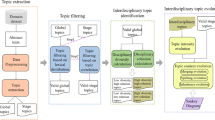Abstract
Two layers of enriched information are constructed for communities: a paper-to-paper network based on shared author relations and a paper-to-paper network based on shared word relations. k-means and VOSviewer, a modularity-based clustering technique, are used to identify publication clusters in the two networks. Results show that a few research topics such as webometrics, bibliometric laws, and language processing, form their own research community; while other research topics contain different research communities, which may be caused by physical distance.









Similar content being viewed by others
Notes
See data and interactive visualizations at http://info.slis.indiana.edu/~eyan/papers/cluster/.
References
Allen, C. (2004). Life with alacrity: The Dunbar number as a limit to group sizes. Retrieved 19 April 2010 from http://www.lifewithalacrity.com/2004/03/the_dunbar_numb.html.
Åström, F. (2010). The visibility of information science and library science research in bibliometric mapping of the LIS field. The Library Quarterly, 80(2), 143–159.
Blei, D. M., Ng, A. Y., & Jordan, M. I. (2003). Latent Dirichlet allocation. Journal of Machine Learning Research, 3, 993–1033.
Blei, D. M., & Lafferty, J. D. (2007). A corrected model of science. Annals of Applied Statistics, 1, 17–35.
Clauset, A., Newman, M. E. J., & Moore, C. (2004). Finding community structure in very large network. Physical Review E, 70, 066111.
Ding, Y. (2011). Community detection: Topological vs. topical. Journal of Informetrics. doi:10.1016/j.joi.2011.02.006.
Donetti, L., & Munoz, M. A. (2004). Detecting network communities: A new systematic and efficient algorithm. Journal of Statistical Mechanics: Theory and Experiment, 2004, P10012.
Dunbar, R. (1998). Grooming, gossip, and the evolution of language. Boston: Harvard University Press.
Farkas, I., Ábel, D., Palla, G., & Vicsek, T. (2007). Weighted network modules. New Journal of Physics, 9(6), 180–209.
Fortunato, S. (2010). Community detection in graphs. Physics Reports, 486(3–5), 75–174.
Girvan, M., & Newman, M. E. J. (2002). Community structure in social and biological networks. Proceedings of the National Academy of Sciences of the United States of America, 99(12), 7821–7826.
Hofmann, T. (1999). Probabilistic latent semantic indexing. In Proceedings of the 22nd Annual International ACM SIGIR Conference on Research and Development in Information Retrieval (pp. 50–57), 15–19 Aug 1999, Berkeley, CA.
Leskovec, J., Lang, K. J., Dasgupta, A., & Mahoney, M. W. (2008). Community structure in large networks: Natural cluster sizes and the absence of large well-defined clusters. Retrieved 21 Mar 2010 from http://arxiv.org/abs/0810.1355.
Li, D., He, B., Ding, Y., Tang, J., Sugimoto, C., Qin, Z., et al. (2010). Community-based topic modeling for social tagging. In The 19th ACM International Conference on Information and Knowledge Management (CIKM2010) (pp. 1565–1568), 26–30 Oct 2010, Toronto, Canada.
Morris, S. A., & Van der Veer Martens, B. (2008). Modeling and mapping of research specialties. Annual Review of Information Science and Technology, 42(1), 213–295.
Newman, M. E. J. (2001). The structure of scientific collaboration networks. Proceedings of the National Academy of Sciences of the United States of America, 98(2), 404–409.
Newman, M. E. J. (2006). Modularity and community structure in networks. Proceedings of the National Academy of Sciences of the United States of America, 103(23), 8577–8582.
Newman, M., & Girvan, M. (2004). Finding and evaluating community structure in networks. Physical Review E, 69, 026113.
Nisonger, T. E., & Davis, C. H. (2005). The perception of library and information science journals by LIS education deans and ARL library directors: A replication of the Kohl-Davis study. College & Research Libraries, 66, 341–377.
Persson, O. (1994). The Intellectual base and research fronts of JASIS 1986–1990. Journal of the American Society for Information Science, 45(1), 31–38.
Radicchi, F., Castellano, C., Cecconi, F., Loreto, V., & Parisi, D. (2004). Defining and identifying communities in networks. Proceedings of the National Academy of Sciences of the United States of America, 101(9), 2658–2663.
Richardson, T., Mucha, P. J., & Porter, M. A. (2009). Spectral tripartitioning of networks. Physical Review E, 80, 036111.
Steyvers, M., Smyth, P., Rosen-Zvi, M., & Griffiths, T. (2004). Probabilistic author-topic models for information discovery. In Proceedings of the Tenth ACM SIGKDD International Conference on Knowledge Discovery and Data Mining (pp. 306–315). New York: ACM Press.
Tang, J., Zhang, J., Yao, L., Li, J., Zhang, L., & Su, Z. (2008). ArnetMiner: Extraction and mining of academic social networks. In Proceedings of the Fourteenth ACM SIGKDD International Conference on Knowledge Discovery and Data Mining (pp. 990–998), Las Vegas.
Waltman, L., van Eck, N. J., & Noyons, E. C. M. (2010). A unified approach to mapping and clustering of bibliometric networks. Journal of Informetrics, 4(4), 629–635.
Waltman, L., Yan, E., & van Eck, N. J. (2011). A recursive field-normalized bibliometric performance indicator: An application to the field of library and information science. Scientometrics, 89(1), 301–314.
White, H. D. (2003). Pathfinder networks and author cocitation analysis: A remapping of paradigmatic information scientists. Journal of the American Society for Information Science, 54(5), 423–434.
White, H. D., & Mccain, K. W. (1998). Visualizing a discipline: An author co-citation analysis of information science, 1972–1995. Journal of the American Society for Information Science, 49(4), 327–355.
Yan, E., Ding, Y., & Zhu, Q. (2010). Mapping library and information science in China: A coauthorship network analysis. Scientometrics, 83(1), 115–131.
Acknowledgments
The authors would like to thank Ludo Waltman, Nees van Eck, and Ed Noyons for introducing VOSviewer and their comments to the idea of this paper.
Author information
Authors and Affiliations
Corresponding author
Rights and permissions
About this article
Cite this article
Yan, E., Ding, Y. & Jacob, E.K. Overlaying communities and topics: an analysis on publication networks. Scientometrics 90, 499–513 (2012). https://doi.org/10.1007/s11192-011-0531-6
Received:
Published:
Issue Date:
DOI: https://doi.org/10.1007/s11192-011-0531-6




